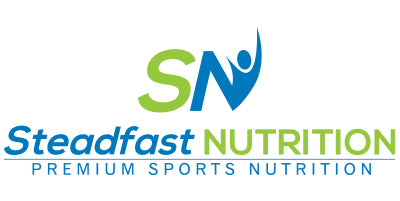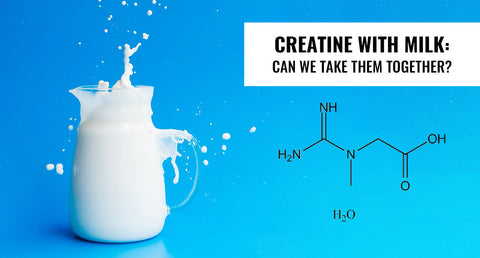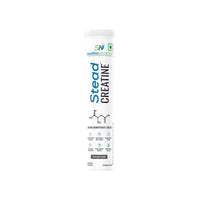Table of Content
Creatine is a widely-used supplement in the fitness world, known for energising and enhancing muscle growth, along with improving strength and exercise performance. It occurs naturally in muscles and the brain and can also be found in small amounts in organ meats and fish. It is stored in the muscles for energy after conversion into creatine phosphate or phosphocreatine. While typically mixed with water or juice, having creatine with milk may work wonders, especially as it doesn’t alter the beneficial aspects.
The good news: taking creatine with milk is both safe and beneficial. Milk complements creatine as a source of protein and carbohydrates, making it suitable for muscle building. However, mixing with milk doesn't provide significant advantages over other liquids other than increasing the protein content overall from milk. It's more about personal preference.
This article delves into the potential benefits and drawbacks of combining creatine and milk, helping you decide if this "fitness power duo" is the right choice for your routine.
What is Creatine?
Creatine is a naturally-occurring compound synthesised by the liver, kidneys, and pancreas and stored in the skeletal muscles. It is also present in small amounts in foods like red meat, chicken, and fish.
Creatine plays a vital role in energy production, particularly during high-intensity, short-duration activities such as sprinting or weightlifting. It helps replenish adenosine triphosphate (ATP), the body's primary energy source, by donating a phosphate group through its stored form, phosphocreatine. This process fuels muscles with energy, improving strength, power output, and muscle endurance.
As a supplement, creatine monohydrate is the most popular and effective form, widely used by athletes to enhance performance, promote muscle growth, and support recovery, especially during high-intensity activities.
The most common form of creatine is creatine monohydrate, renowned for its efficacy and safety. Other forms include:
- Creatine hydrochloride (HCL): Known for better solubility due to smaller particle size, ensuring rapid absorption and reduced bloating.
- Buffered creatine: Promotes greater creatine retention & designed to minimise stomach discomfort.
- Micronised creatine: A finer version of creatine monohydrate for easier mixing.
- Creatine ethyl ester: Claimed to improve absorption, though less commonly used.
Typical Use:
- Pre-Workout: Creatine is often taken before workouts to boost energy and maximise performance during intense exercise.
- Post-Workout: Many prefer taking creatine after exercise to aid in recovery and support muscle growth when combined with protein or carbohydrates.
Timing for consuming creatine supplements is flexible, as the overall goal is maintaining muscle creatine saturation, making consistency more critical than exact timing.
Can You Take Creatine with Milk?
Yes, you can take creatine with milk, and it can be an effective combination for muscle growth and recovery. Milk's proteins—both slow-digesting casein and fast-digesting whey—aid in muscle repair and protein synthesis, while creatine boosts energy by increasing phosphocreatine levels in muscles, enhancing workout performance and recovery. The combination also provides additional nutrients like calcium and vitamin D, supporting overall health.
Taking creatine with milk post-workout is particularly beneficial for supporting muscle repair. For those who are lactose intolerant, alternative liquids like water, juice, or plant-based milk are better options. However, for individuals without lactose concerns, milk offers a nutrient-dense and flavourful alternative, making it a convenient and effective choice to pair with creatine.
Benefits of Taking Creatine with Milk
Here are a few creatine benefits when mixed with milk. Read on to know more:
- Enhanced Absorption: Proteins and fats in milk improve creatine uptake and retention, potentially shortening the loading phase.
- Muscle Growth & Recovery: Milk’s whey and casein proteins support muscle repair, growth, and protein synthesis along with supplying energy to the muscles.
- Additional Calories: Milk provides calories, beneficial for weight gain and muscle building.
- Improved Taste: Milk enhances the flavour and texture of creatine by acting as a base, encouraging consistent intake.
- Better Solubility: Warm milk reduces clumping, making it easier to mix creatine and improving the solubility.
- Cognitive Benefits: Combined with milk, creatine may support brain function and energy metabolism.
- Ideal for Athletes: Creatine provides a quick boost in energy and boosts strength, promoting endurance and recovery, particularly for high-intensity sports.
- Nutritionally Packed: Milk provides natural sugars for quick energy and recovery, essential nutrients like calcium and vitamins for bone health and metabolism, and versatility with whole milk aiding bulking, while creatine protects the muscles and retains water during the cutting phase.
This combination makes creatine and milk a nutrient-packed option for better performance and recovery.
Best Way to Take Creatine
As creatine pulls water into the muscles, it can be taken with water, juice, milk or any liquid to maintain hydration. Warm liquids also make the dissolving process easy without compromising the nutritional value. The best way to take creatine involves choosing a method that suits your preference and dietary needs while maintaining daily consistency. For loading phase, 20 g/day can be consumed to rapidly saturate muscles, while 3-5g/day can be taken during the maintenance phase. Pairing creatine with carbohydrate-rich meals enhances absorption due to insulin spikes, and timing it close to workouts (pre or post) may improve effectiveness. Ensure adequate hydration to prevent dehydration.
Consumption Options:
- Water: Ideal for lactose-intolerant individuals.
- Fruit Juice: Masks the taste and aids absorption.
- Protein Shakes: Combine with milk or dairy-free alternatives for added protein.
- Gummies: A convenient, texture-free alternative.
Consistency is key, with a standard daily dose of 3-5 g ensuring muscle creatine stores remain saturated for optimal results.
The best creatine supplement is Steadfast's SteadCreatine effervescent tablet which delivers 1500 mg of creatine monohydrate, enhancing energy production through ATP generation. This improves muscle growth, muscle strength, and endurance and speeds recovery while promoting muscle growth by retaining water in muscle tissues supporting those in cutting phase. It is perfect for athletes in short and high-intensity sports such as bodybuilding, weightlifting, sprinting, cycling, and hockey.
Potential Concerns with Taking Creatine with Milk:
1. Digestive Issues:
Lactose-intolerant individuals may experience stomach discomfort, bloating, or loose stools. Lactose-free or non-dairy milk can be alternatives.
2. Non-Essential for Absorption:
Milk is not required for creatine absorption, dissolving it in water can also work effectively.
3. Nutrient Interactions:
Calcium in milk may potentially interfere with creatine uptake, though more research is needed.
4. Extra/Unwanted Calories:
Milk adds 55-150 kcal per 240 ml, which may be unsuitable for those limiting calorie intake. Water, with 0 kcal, is a better choice.
5. Bloating:
Creatine supplementation can sometimes cause bloating due to water being drawn into muscle cells, particularly during a high-dose loading phase (20 g per day for about 5-7 days). This water retention can lead to temporary weight gain and discomfort. However, according to the research in 2021 published in the Journal of the International Society of Sports Nutrition suggests that taking smaller doses (10 g or less) over a longer period can achieve similar muscle saturation without the bloating effect.
While creatine is generally safe, some individuals may experience side effects such as weight gain from water retention, dizziness, nausea, vomiting, diarrhea, or excessive sweating. To minimise these effects, it is recommended to divide the total daily dose into smaller portions and consume them throughout the day rather than all at once. By adjusting dosage and timing, creatine can be taken effectively with fewer side effects.
Creatine and Kidney Health:
Creatine is generally safe when taken within recommended doses. Lower doses can be safe for long-term usage but people having kidney disease, high blood pressure, or liver disease should not consume creatine without advice from a healthcare professional. Concerns about kidney damage from increased kidney disease markers in urine, do not necessarily indicate harm. Excessive creatine intake, intense training, or steroid use may exacerbate kidney-related symptoms. If consuming creatine regularly, pay attention to adequate hydration, as the body starts breaking down muscles to derive the water it needs, which can result in dehydration, muscle cramps, headache, along with low energy levels. Insufficient water intake while taking creatine supplements can also lead to abdominal discomfort and kidney issues in the long run.
Conclusion
Creatine is a well-studied and generally safe supplement when consumed in recommended doses. Milk can be a mixing option since it improves creatine uptake and supports muscle recovery. However, it is not essential for creatine absorption and may cause digestive issues, add unwanted calories, or interfere with creatine uptake due to calcium content. Water remains a calorie-free and effective alternative. Concerns about kidney health are often linked to excessive intake or intense training routines, but creatine poses no significant risk to kidney function in healthy individuals when used responsibly.


